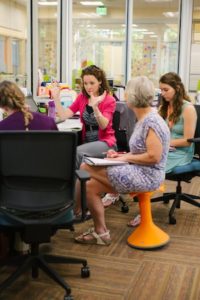In my role as an instructional coach, two of my biggest challenges were implementing productive professional-learning structures to work with the teachers I served and finding substantive time to do that work. I could squeeze in time here and there, but having dedicated time in a productive learning community was a consistent challenge. Fortunately, my principal was one of the most innovative instructional leaders with whom I’ve ever worked, and we set out to find a way to address both issues. The plan we came up with gave us the opportunity to put in place a professional learning structure that would allow us to work alongside our teachers and the time necessary for deep learning.

What Does the Literature Say?
While reviewing the literature and research and reflecting on our own experiences, it became clear that for professional learning to impact teacher practice, it needs to be job-embedded and to allow teachers to collaborate. For this reason we decided to create opportunities to engage in grade-level modified lesson-study experiences that would allow us to:
- Engage in professional readings and conversations
- Plan a lesson and intentional instructional moves collaboratively
- Observe the planned lesson and collect data
- Reflect on interpreting student data based on the lesson focus
- Discuss the instructional implications for planning
Creating the Opportunity for Learning and Collaboration
Once we determined the goals and structure of our professional learning based on best practices, we were determined to find the time for this learning to occur. We decided that we would meet with grade-level teams for a half-day every Wednesday. This schedule would allow three-hour blocks of time with each grade level once every four weeks. Since we didn’t have the budget for substitute/guest teachers every week, we looked for creative ways to provide meaningful learning opportunities for the students while engaging teachers in a modified lesson-study experience.
We turned to our Related Arts teachers. This team of dedicated professionals were willing to teach the students, rotate them between classes, and get them to lunch so that grade-level teams could have uninterrupted time for professional learning and collaboration! Making this happen was no easy task. It took patience and dedication. The logistics of lunches, timing of rotations, and behavioral expectations were all considerations that had to be carefully crafted.
Was it perfect? No. Did we always have enough time to accomplish all our goals? No. Did we come together to think about our instructional practices in a way that allowed us to reflect and collaborate? Yes!
It would have been easy to say that the time investment was unrealistic, or that the logistical challenges were too great, or that the lesson-study experience could not function in this setting, but instead we utilized our greatest resource—our school community—to pioneer a way of work that was messy and real and collaborative!
Learn More!
If you would like to learn more about Collaborative Classroom’s unique approach to professional learning, including upcoming professional learning opportunities, blogs, and other resources, visit our Professional Learning page here.
